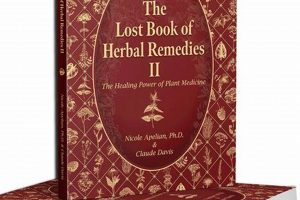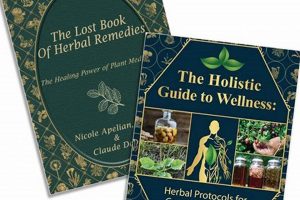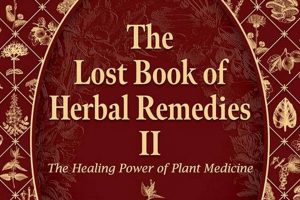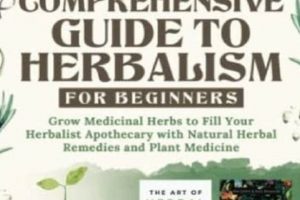A compilation documenting the traditional use of plants for medicinal purposes within Jamaica constitutes a valuable resource. This type of publication catalogs indigenous knowledge related to plant identification, preparation methods (such as infusions and poultices), and the ailments they are traditionally used to treat. An instance would be a published work detailing the use of cerasee for blood purification or guinea hen weed for immune support, based on long-standing cultural practices.
The significance of such a resource lies in its preservation of cultural heritage, offering insights into traditional healing practices passed down through generations. Its benefits extend to providing potential avenues for scientific research, exploring the pharmacological properties of Jamaican flora. Historically, these publications have served as important references for ethnobotanists, researchers, and individuals interested in natural remedies, contributing to a broader understanding of plant-based medicine.
The following article will delve into specific examples of plants featured within these publications, examine the scientific validation of their traditional uses where available, and discuss the ongoing efforts to document and preserve this valuable knowledge for future generations.
Guidance Derived From Jamaican Ethnobotanical Compilations
The following guidance is drawn from the documented knowledge within compilations detailing Jamaica’s traditional herbal medicine practices. Adherence to responsible and informed use is strongly advised.
Tip 1: Prioritize Accurate Plant Identification: Correct identification of plant species is paramount. Misidentification can lead to the use of incorrect or even harmful plants. Consult reputable botanical resources and, if possible, experienced herbalists familiar with Jamaican flora before utilizing any plant.
Tip 2: Understand Preparation Methods: Traditional preparations often involve specific techniques, such as decoctions, infusions, or macerations. Accurate replication of these methods is crucial for achieving the desired therapeutic effect and minimizing potential adverse reactions. Consult the source materials closely for detailed instructions.
Tip 3: Be Mindful of Dosage: Dosage recommendations in traditional medicine are often based on experience and observation. It is essential to begin with conservative doses and carefully monitor for any adverse effects. Recognize that dosages may vary based on individual factors such as age, weight, and overall health status.
Tip 4: Consider Potential Interactions: Herbal remedies can interact with pharmaceutical medications. Individuals taking prescription drugs should consult with a qualified healthcare professional before using any herbal remedies to avoid potentially harmful interactions. Research any known interactions of the plant in question.
Tip 5: Exercise Caution During Pregnancy and Breastfeeding: Many herbs are contraindicated during pregnancy and breastfeeding. The use of herbal remedies during these periods requires the guidance of a knowledgeable healthcare practitioner familiar with both traditional medicine and prenatal/postnatal care.
Tip 6: Document Use and Effects: Maintaining a detailed record of the herbal remedies used, dosages, and any observed effects (positive or negative) can provide valuable information for personal monitoring and for informing future use. This practice can also be useful for sharing information with healthcare providers.
Tip 7: Support Sustainable Harvesting Practices: When sourcing plants, prioritize sustainable harvesting methods to ensure the long-term availability of these resources. Avoid over-collection and respect the natural environment. Support local growers and harvesters who adhere to responsible practices.
Adherence to these guidelines promotes the responsible and informed use of traditional Jamaican herbal knowledge. It underscores the necessity for combining traditional wisdom with contemporary healthcare practices.
The next section explores specific plants and their documented uses within the context of Jamaican traditional medicine.
1. Ethnobotanical documentation
Ethnobotanical documentation forms the bedrock of any authoritative compilation detailing Jamaican herbal remedies. It represents the systematic recording of traditional knowledge regarding the use of plants for medicinal purposes by the Jamaican people. Without rigorous ethnobotanical study, a purported “jamaican herbal remedies book” lacks authenticity and reliability.
- Plant Identification and Nomenclature
Accurate identification of plant species is crucial. Ethnobotanical documentation ensures proper botanical nomenclature is recorded alongside local names, preventing confusion and enabling scientific verification. For example, the documentation would clearly differentiate between various species of Piper used medicinally in Jamaica, providing both the scientific name ( Piper umbellatum) and common names (e.g., “cow foot”) to prevent misidentification.
- Traditional Preparation Methods
The methods employed in preparing herbal remediesdecoctions, infusions, poulticesare meticulously documented. The specific parts of the plant used (leaves, roots, bark), the duration of preparation, and any additional ingredients are recorded. A reputable “jamaican herbal remedies book” would, for instance, detail the precise steps involved in preparing a cerasee tea, specifying the amount of cerasee vine required, the volume of water, and the steeping time.
- Medicinal Uses and Dosage
The traditional applications of each plant are thoroughly recorded, noting the specific ailments treated and the methods of administration. Documenting dosage is essential, although often challenging due to variations in preparation and individual response. An example would be documenting the use of guinea hen weed for fever, including the recommended amount to be consumed and the frequency of administration.
- Cultural Context and Beliefs
Ethnobotanical documentation extends beyond mere botanical data, encompassing the cultural context surrounding plant use. This includes traditional beliefs, rituals, and social practices associated with the plants. The “jamaican herbal remedies book” may explore the cultural significance of certain plants used in traditional healing ceremonies or the role of herbalists within the community.
Ultimately, ethnobotanical documentation provides the crucial link between traditional knowledge and accessible information. It is this process that transforms anecdotal practices into a structured and verifiable resource, thereby providing the backbone of a reliable compilation of Jamaican herbal remedies. Without it, a “jamaican herbal remedies book” is merely speculation, rather than a reflection of established cultural practices.
2. Traditional preparation methods
A vital aspect of any “jamaican herbal remedies book” centers on the detailed documentation of traditional preparation methods. These methods dictate how raw plant material is transformed into therapeutic remedies, influencing both efficacy and safety. Accurate recording of these techniques is paramount for preserving cultural knowledge and enabling responsible application.
- Decoctions: Extraction by Boiling
Decoction involves boiling plant material, typically roots, bark, or seeds, in water for a specific duration. This method extracts heat-stable compounds. A “jamaican herbal remedies book” might specify decoction preparation for strongback (Desmodium incanum) to release its purported strengthening properties. Variations in boiling time directly affect the concentration and potential toxicity of the resulting liquid.
- Infusions: Soaking in Hot Water
Infusion, also known as steeping, involves soaking plant parts, often leaves or flowers, in hot water. This method is suitable for extracting volatile oils and delicate compounds. A relevant book could illustrate the infusion process for fever grass (lemongrass; Cymbopogon citratus), used traditionally for teas to alleviate fever. Steeping time and temperature impact the flavor and medicinal potency of the infusion.
- Poultices: Topical Application of Plant Matter
Poultices involve applying crushed or mashed plant material directly to the skin, often bound with cloth. This method allows direct contact between the plant’s compounds and the affected area. A typical volume would explain the preparation of a poultice from aloe vera (Aloe barbadensis miller) to soothe burns or skin irritations. The type of plant material, its freshness, and the duration of application impact its effectiveness.
- Maceration: Cold Water Extraction
Maceration involves soaking plant material in cold water for an extended period. This method is suitable for extracting compounds that are sensitive to heat. A reference text could illustrate the preparation of a maceration of Chaney root (Smilax regelii), traditionally employed for its purported blood-purifying qualities. The duration of soaking, the plant-to-water ratio, and the storage conditions affect its potency and shelf life.
These traditional preparation methods, carefully documented in a “jamaican herbal remedies book,” reflect the accumulated knowledge of generations. Accurate recording of these processes is essential for ensuring the remedies are prepared and used responsibly and effectively.
3. Medicinal plant identification
Medicinal plant identification is a foundational element underpinning the credibility and utility of any “jamaican herbal remedies book.” Accurate identification is non-negotiable; misidentification can lead to ineffective treatments or, more seriously, adverse health consequences. It forms the primary defense against unintended harm and ensures that the intended therapeutic benefits are achievable.
- Botanical Nomenclature and Verification
Accurate use of botanical nomenclature (scientific names, e.g., Cannabis sativa) is critical. A “jamaican herbal remedies book” must provide both the scientific name and common Jamaican names. Verification through herbarium specimens or expert botanists reinforces the reliability of the identification. Improper use of names breeds confusion and limits scientific scrutiny.
- Visual Identification Aids: Photographs and Illustrations
High-quality photographs and detailed illustrations are essential for visual identification. A “jamaican herbal remedies book” benefits immensely from including multiple perspectives of the plant, highlighting key identifying features such as leaf shape, flower structure, and stem characteristics. Clear visual aids assist users in confidently identifying plants in their natural environment and reduce the likelihood of error.
- Distinguishing Characteristics: Habitat and Morphology
Habitat information (e.g., preferred soil type, altitude, sunlight exposure) and morphological descriptions (e.g., plant height, leaf arrangement, bark texture) are crucial for accurate identification. A “jamaican herbal remedies book” should provide detailed descriptions of the plant’s lifecycle and its typical habitat to aid in differentiation from similar species. Overlooking these factors can result in misidentification and potentially harmful substitution.
- Potential for Look-Alike Species and Toxicity
A responsible “jamaican herbal remedies book” must explicitly address the potential for confusion with look-alike species, particularly those known to be toxic. This involves detailing the key differences between similar plants and providing warnings about the dangers of misidentification. Proactive disclosure reduces the risk of accidental poisoning and ensures the safety of users.
These facets, when meticulously integrated into a “jamaican herbal remedies book,” elevate it from a mere collection of folklore to a scientifically informed resource. Accurate medicinal plant identification provides the bedrock upon which safe and effective herbal practices can be built.
4. Cultural preservation importance
The inextricable link between a compilation of Jamaican herbal remedies and the imperative of cultural preservation cannot be overstated. The creation and dissemination of a “jamaican herbal remedies book” directly serves to document and safeguard traditional ecological knowledge (TEK) passed down through generations. This knowledge, encompassing plant identification, preparation techniques, and therapeutic applications, constitutes a significant aspect of Jamaica’s cultural heritage. Neglecting this preservation would lead to the erosion of invaluable knowledge, potentially lost to future generations due to factors such as globalization, changing lifestyles, and the passing of elders who hold this traditional wisdom.
The importance of cultural preservation manifests practically through several avenues. Firstly, the existence of a documented resource empowers local communities to maintain and transmit their heritage. For instance, by providing detailed accounts of herbal practices once common in rural areas but now fading, the publication can serve as a revitalizing force, encouraging younger generations to learn from their elders. Secondly, such documentation can be used in educational programs, both formal and informal, to promote cultural awareness and appreciation. Thirdly, the documented knowledge can be used to support sustainable development initiatives that are rooted in traditional practices, such as promoting the cultivation and sustainable harvesting of medicinal plants to provide economic opportunities for local communities while preserving the environment. Finally, it acts as a counterpoint to cultural homogenization.
In conclusion, the creation of a “jamaican herbal remedies book” is not merely a scientific or botanical endeavor; it is a crucial act of cultural stewardship. It ensures that the wealth of traditional knowledge surrounding Jamaican herbal medicine is not lost but rather preserved, valued, and used to benefit current and future generations. The publication serves as a tangible embodiment of cultural identity, fostering a sense of pride and continuity within the Jamaican community, while simultaneously providing valuable insights for researchers and practitioners interested in traditional medicine globally. Challenges remain in ensuring the equitable sharing of benefits arising from the commercialization of this knowledge and the protection of intellectual property rights, but the fundamental importance of cultural preservation remains paramount.
5. Potential scientific validation
The pursuit of scientific validation represents a critical juncture in the life cycle of knowledge documented within a “jamaican herbal remedies book.” While the book preserves traditional practices, scientific investigation offers the opportunity to objectively assess the efficacy and safety of these remedies, potentially leading to broader acceptance and integration into modern healthcare practices.
- Chemical Composition Analysis
Identifying the active chemical constituents within Jamaican medicinal plants is a fundamental step in scientific validation. For instance, a “jamaican herbal remedies book” may document the use of cerasee ( Momordica charantia) for managing blood sugar. Scientific analysis would involve isolating and identifying compounds within the plant, such as charantin and vicine, that may contribute to this effect. This analysis lays the groundwork for understanding the plant’s mechanism of action.
- In Vitro and In Vivo Studies
Following chemical analysis, in vitro (laboratory) and in vivo (animal) studies are conducted to evaluate the biological activity of the plant extracts or isolated compounds. Using the cerasee example, in vitro studies might assess the ability of charantin to inhibit glucose absorption, while in vivo studies could evaluate its effect on blood glucose levels in diabetic animal models. These studies provide preliminary evidence supporting or refuting the traditional uses described in the “jamaican herbal remedies book.”
- Clinical Trials
The most rigorous form of scientific validation involves conducting clinical trials on human subjects. This requires adherence to strict ethical guidelines and rigorous methodology. Hypothetically, a clinical trial could be designed to evaluate the effectiveness of a standardized cerasee extract in managing blood sugar levels in patients with type 2 diabetes. The results of such trials provide definitive evidence regarding the clinical efficacy and safety of the remedy.
- Standardization and Quality Control
Scientific validation also necessitates the development of standardized protocols for plant cultivation, harvesting, and processing, as well as stringent quality control measures. This ensures that the composition of the herbal remedy is consistent and that it is free from contaminants. A “jamaican herbal remedies book” informed by scientific validation would include guidelines for ensuring the quality and authenticity of the herbal preparations, leading to reliable and reproducible results.
The potential for scientific validation transforms a “jamaican herbal remedies book” from a repository of traditional knowledge into a foundation for evidence-based medicine. While not all traditional remedies will withstand scientific scrutiny, the process of investigation provides valuable insights into the pharmacological properties of Jamaican flora and can contribute to the development of novel therapeutic agents. Furthermore, the integration of scientific findings into updated editions of such books can bridge the gap between traditional practices and modern healthcare, promoting safer and more effective use of herbal remedies.
Frequently Asked Questions about Jamaican Herbal Remedies
The following addresses prevalent inquiries concerning compilations documenting Jamaican herbal remedies, their application, and associated considerations.
Question 1: What constitutes a reputable publication detailing Jamaican herbal remedies?
A credible resource provides accurate botanical nomenclature (scientific names alongside common names), detailed preparation methods, clear dosage guidelines, and substantiated sources. It emphasizes safety and acknowledges potential interactions with conventional medications.
Question 2: Can the information within a “jamaican herbal remedies book” substitute professional medical advice?
No. The information contained within such a book serves as a supplementary resource. It should not replace consultation with a qualified healthcare professional for diagnosis, treatment, or management of any medical condition.
Question 3: How can one verify the accuracy of plant identification within a “jamaican herbal remedies book”?
Cross-referencing information with multiple botanical resources, consulting with experienced herbalists or botanists, and comparing the plant to herbarium specimens aids in confirming plant identification. Caution must be exercised to avoid misidentification, which can have adverse consequences.
Question 4: Are traditional Jamaican herbal remedies safe for everyone?
Safety depends on individual factors, including age, health status, allergies, and concurrent medication use. Certain herbs are contraindicated during pregnancy, breastfeeding, and for individuals with specific medical conditions. Consultation with a healthcare provider is essential before using any herbal remedy.
Question 5: What are the potential risks associated with using herbal remedies described in a “jamaican herbal remedies book”?
Potential risks include allergic reactions, adverse interactions with medications, toxicity due to improper dosage or preparation, and contamination of plant material. Informed use and adherence to recommended guidelines are crucial to minimize these risks.
Question 6: How does scientific research contribute to the understanding of Jamaican herbal remedies?
Scientific studies can validate traditional uses, identify active compounds, assess efficacy, and evaluate safety. This research informs evidence-based use and may lead to the development of novel therapeutics derived from Jamaican flora. However, not all traditional remedies have been scientifically investigated, and further research is warranted.
Adherence to these guidelines promotes the responsible and informed use of knowledge derived from compilations of Jamaican herbal remedies. This underscores the necessity for combining traditional wisdom with contemporary healthcare practices.
The succeeding section delves into legal and ethical considerations relevant to the creation and utilization of “jamaican herbal remedies book” publications.
Concluding Observations on Jamaican Herbal Compilations
This exploration has underscored that a “jamaican herbal remedies book” represents more than a simple list of plants and their uses. It embodies a complex intersection of ethnobotanical knowledge, cultural heritage, and the potential for scientific validation. Accurate documentation of plant identification, traditional preparation methods, and dosage guidelines are paramount. The preservation of cultural context and the responsible application of this information are equally crucial. Scientific investigation offers the opportunity to rigorously evaluate efficacy and safety, bridging the gap between traditional practices and modern medicine.
The continued compilation and ethical application of the knowledge contained within a “jamaican herbal remedies book” demands a multi-faceted approach. This includes supporting ethnobotanical research, engaging local communities in preservation efforts, and promoting responsible use informed by both traditional wisdom and scientific inquiry. Only through such diligent and ethical practices can the true value of this cultural and potential medical resource be realized and its integrity ensured for generations to come.







